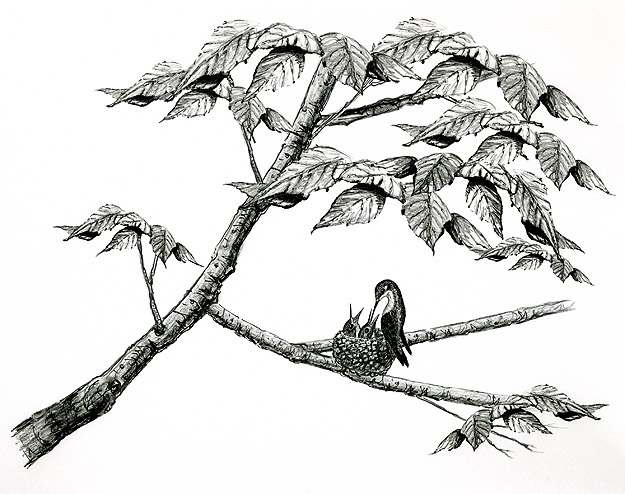
Dear Bird Folks,
It’s great to have the hummingbirds back. I get a lot of them at my feeder each summer, but I have never found a hummer’s nest. Do you have any suggestions of where to look? And do they build a new nest for each brood?
– Lily, Princeton, NJ
Good luck, Lily,
I don’t know how much help I’m going to be with your nest quest. I too have spent years looking for a hummer’s nest and have always come up empty. One year I thought I had finally found one. I was scanning a field with my binoculars when I spotted a tiny nest on the top of a thin pole. My heart was pounding. I could hardly breathe as I watched intently, hoping to see the mother return to feed her babies. After five minutes of staring I was rewarded when the female finally arrived…carrying a nice big fish. Wait! A fish? Oh, nuts. I wasn’t seeing a hummingbird’s nest; it was an Osprey platform. I was looking through the wrong end of my binoculars, again. Stupid binoculars. They should put better instructions on those things.
Hummingbirds are indeed back. I know this because lots of folks are calling to ask, once again, how to make hummingbird food. (Four parts water to one part sugar.) Everyone seems to enjoy hummingbirds. We marvel at their tiny size, at their flying skills, and at the fact that they able to fly thousands of miles, and yet can locate exactly the same feeder they ate from a whole year ago. It’s ironic that the birds can find our feeders, when many of us can’t. Most of the new feeders we sell are to customers who have forgotten where they stored their old feeder from the year before. (I love irony, especially when it helps allows me to sell more feeders.)
Much has been written about the hummingbirds’ migration and flying abilities, but their mating habits are also unique. We all love it when we learn that birds mate for life, or at least have a rock-solid pair bond during the mating season. This is so not the case with hummingbirds. They hate that mushy stuff. In fact, they hate each other. Female hummingbirds are extremely resourceful, independent and have almost no use for males. The key word, of course, is “almost.” With the exception of that “almost,” female hummers would do just fine if the males never even existed. (I know a few women who would agree with them.)
When most female birds arrive on their breeding grounds they immediately begin to look for a mate. Not Ms. Hummer. Mating is the last thing on her mind. The first thing she does upon arrival is build a nest, and she does it alone. She doesn’t need to have a mate telling her where and how to build it, or have to put up with the gross habits of some sloppy live-in boyfriend. She does it all on her own. Once her nest is completed, she takes a quick trip over to a male’s territory, does what she has to do, and is done with him. (Sounds like my kind of girl.)
As you can imagine, a Ruby-throat’s nest is small, only about the size of a shot glass. (Don’t ask me how I know how big a shot glass is. I just do.) The outside of the nest is camouflaged with lichen. With the skills of a finish carpenter, the female carefully “shingles” the outside of her nest with bits of lichen, which are usually taken from the host tree. The nest is typically built on a thin (about the thickness of a pencil) downward-sloping, forked branch. The nest is about ten to twenty feet above the ground, but it may be lower. Most nests are located just below a layer of foliage. The foliage not only hides the nest from predators, but it also provides protection from rain and the heat of the summer sun. Remember, female hummers are single moms. There is no male, friendly neighbor or mother-in-law to watch her kids while she is off gathering food. Foliage is all she has to protect her babies when she’s not there.
Finding an active hummingbird nest is not an easy thing to do. The female rarely flies directly back to her nest; she often makes several false stops along the way. You could try to locate a nest in the fall, when the leaves are off the trees: just look for a lichen covered shot glass sitting on the end of a skinny forked branch. If you do find a hummingbird’s nest, Lily, you might be tempted to take it home and display it on your mantel next to your favorite piece of driftwood or the conch shell you found in Florida. Don’t do that. Mother hummer often uses the same nest year after year. Not having to build a new nest for each brood saves her tons of extra work. And if any bird could stand to do a little less work, it’s her.
A few more thoughts: Once again, the formula for making hummingbird food is four parts water to one part sugar. Red food coloring is not required and not recommended. However, changing the food and cleaning your feeder twice a week is important. If Ms. Hummer visits your feeder and it’s not fresh, she may not return. She’ll simply cast you aside like she’s done to all of the males she’s met over the years. You don’t want to end up like them.